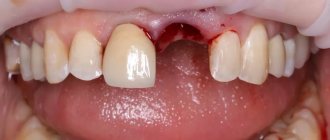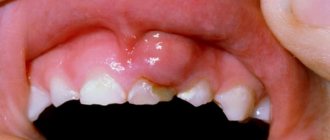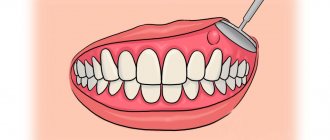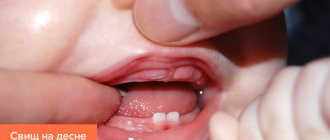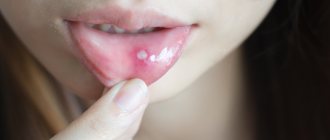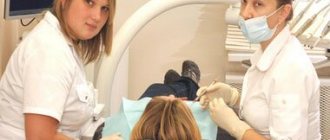Persuading a child to go to the dentist is not an easy task, especially when dental treatment is required. Sometimes it takes 2-3 days to persuade, and sometimes a whole week. But if caries at the initial stage can still be tolerated, then an abscess on the gum requires urgent medical intervention.
Yes, sometimes a purulent formation can go away on its own. But, as a rule, inflammation returns, especially in autumn or winter, when the child’s immune system is weakened. It is not uncommon for a lump to form during colds. But an abscess can lead to tooth loss or infection of other teeth. Don't wait for the lump to disappear on its own or appear again, contact your pediatric dentist!
Treatment
Depending on whether a permanent or baby tooth caused a lump on the child’s gums , the doctor carries out appropriate treatment. If a permanent tooth is damaged, seek help immediately while there is a chance to save the child’s tooth. The doctor will have to remove the nerve and fill the canals. In this case, adult dental treatment is a necessity, because if high-quality treatment and appropriate treatment are not carried out, the child may lose a tooth.
Milk teeth are removed immediately - their root system has not yet had time to form, and it is impossible to properly fill the canals. In addition, if the diseased tooth is left, the molar may grow back with defects.
The specialists of the Medexpert Center for Family Dentistry will help you
cure or remove a child’s tooth All procedures in the clinic are performed under medical sedation. While the baby is sleeping peacefully and does not feel pain or discomfort, the doctor can carry out all the necessary procedures. The ability to treat teeth in a dream is a real salvation for parents and children. In addition, sedation is safe for the child’s body and even helps to cope with dental phobia.
Why did an abscess appear on the gum?
The main, main cause of abscesses is the penetration of infection into the gum tissue. In this case, a reaction of the body’s defenses occurs: leukocytes that destroy hostile cells die, and a large amount of pus accumulates at the site of infection. As a result, a pus-filled sac forms in the gum tissue, which can gradually increase in size and eventually rupture. Infection can enter the gum tissue in a variety of ways. In addition, the formation is promoted by the presence of diseases of the gastrointestinal tract, immune system, permanent plaque on the teeth and tongue, and smoking.
There are many factors that increase the risk of developing abscesses inside the oral cavity, but ultimately all the reasons come down to two main ones:
- Periodontitis
Periodontitis is a disease in which a focus of infection forms at the very root of the tooth (usually at the apex). The development of periodontitis is caused by untreated caries and advanced pulpitis (inflammation of the soft tissues of the tooth). Often, the infection penetrates into the tissue surrounding the tooth root during dental procedures and manipulations - for example, when the dental canals are not completely cleaned during the treatment of pulpitis or when the filling is not dense enough. The development of periodontitis is also facilitated by the presence of chronic infectious diseases that cause a steady decrease in the activity of the body's defenses, stress and overwork, and the presence of bad habits. Infectious foci often arise under crowns when they are installed poorly.
Sometimes periodontitis can affect two teeth at the same time. Most often, when this disease occurs, patients complain of severe pressing, aching, acute pain and swelling, but in some cases these symptoms may be absent. Over time, pus accumulates inside the gums, and the cavity containing it expands to the boundaries of the outer mucous membrane of the gums. As a result, an “abscess” or fistula (a small hole through which pus comes out) may form on its surface.
A common result of periodontitis is the appearance of cysts or granulomas - benign formations associated with changes in the structure of the tissues of the oral cavity. To diagnose such conditions, X-ray examination is used, which often makes it possible to detect the disease in the early stages of development and prevent the formation of an abscess. However, due to the latent course of the disease in the initial stages, diagnosis is sometimes difficult: often the presence of infection in the root apex is discovered by chance, when examining other teeth.
The release of pus to the surface of the gum and the formation of an abscess on the gum in the mouth is most often accompanied by acute pain. However, if inflammation on the gums does not hurt, this does not mean that the disease is progressing favorably and you can postpone a visit to the dentist. The absence of pain is usually due to the fact that when a fistula or abscess forms, the pressure of pus on the root and nerve of the tooth decreases. But the main cause of the disease, the focus of chronic infection, still persists. In addition, ulcers without pain often turn out to be formations of other types - for example, wen or benign tumors.
If a white abscess forms on the gum, this usually indicates the presence of a focus of inflammation deep in the gum, at the root of the tooth. Due to the deep location of the infectious focus, characteristic signs of inflammation are often absent.
- Periodontitis
Periodontitis is a disease in which “pockets”, areas of sagging gum tissue, form between the lower edge of the teeth and the gums. As a result, cavities are formed in which food debris and bacterial mass accumulate. All this creates the most favorable conditions for the emergence of a focus of infection, which subsequently leads to inflammation.
As a result of the constant presence of pathogenic microorganisms, the part of the gum adjacent to the tooth becomes inflamed, becomes red and swollen, and may bleed when brushing or applying pressure. The deepening of the gum pocket against the background of the constant presence of a source of infection leads to the accumulation of pus in it, as a result of which an abscess is formed.
Unlike periodontitis, with periodontitis the source of inflammation is not deep in the gums, but on the surface. Therefore, even with a simple examination, you can detect characteristic signs of inflammation: swelling and redness. Since periodontitis pockets often form on several or even all teeth of the jaw, the abscesses caused by this disease can also be multiple.
Prevention
- oral hygiene (make sure your baby brushes his teeth properly);
- balanced diet;
- rinsing your mouth every meal;
- preventive procedures (remineralization, fluoridation; fissure sealing);
- timely dental treatment;
- preventive examinations at the dentist 2 times a year.
Timely dental treatment for children and proper oral hygiene are the main weapons in the fight against caries and other diseases. Teach your child to take care of the health of their teeth and beautiful children's smiles will delight you every day!
Folk remedies
The use of traditional methods in the treatment of acne in the mouth is not only acceptable, but also desirable. Most often - rinsing the mouth with decoctions and infusions of medicinal herbs: chamomile, sage, pine needles, bay leaf. Procedures should be carried out regularly after each meal or brushing your teeth. Use only warm liquid for rinsing. To enhance the effect, herbs can be alternated.
Chamomile infusion is great for rinsing
Important! Under no circumstances should you apply a hot compress to the sore spot or rinse your mouth with a hot solution unless prescribed by a doctor! Often patients, not having the time (or desire) to visit the dentist, try to warm up the pimple, stimulating its “ripening and opening.” Such self-medication is fraught with serious complications, including blood poisoning and death.
Another simple and effective remedy is a solution of soda and/or sea salt (you can also use table salt). This rinse quickly eliminates tissue swelling, helps reduce inflammation, and has a drying effect. The method is used as an additional method to the main purposes.
Remember that even folk remedies should not be used as independent treatment protocols. It is necessary to visit a doctor to make a correct diagnosis and prescribe treatment. Herbal medicinal therapy should also be determined by the dentist.
Possible complications
You should not assume that pimples that appear are harmless and will not cause trouble. They cannot be heated, squeezed out, or subjected to mechanical stress.
This will lead to an increase in germs, and the infection will spread quite quickly. Small children often suffer from them, so parents need to be attentive: carefully examine them, monitor their personal hygiene.
Something to remember! A small, inconspicuous pimple will eventually develop into an abscess, and it will damage not only the oral cavity, but also the brain, and this is very scary!
How to treat white pimples on gums in adults
Acne on the gums should be treated comprehensively, based on the origin of the disease. After diagnosis and determination of the type of tumor, a course of medication is prescribed and therapeutic manipulations are carried out. Therapy of cysts and fistulas always requires the involvement of a surgeon to remove the source of infection. In other cases, surgical intervention is necessary only in advanced cases.
For inflammation of bacterial origin, antibacterial therapy is prescribed. Herpes virus is treated with Acyclovir and Viferon-gel, fungal infections with antifungal drugs. Additionally, immunostimulating agents and therapeutic rinses are prescribed.
Diagnostics
It is forbidden to open tumors on your own
A mandatory dental examination will be required.
He will conduct a comprehensive check, find out what diseases are present, and prescribe the appropriate procedure.
If the pimple increases in size, it can be conservative (use of ointments, antiseptics or antibiotics) or surgical.
To identify character, you will need:
- Examination of the patient.
- X-ray examination.
- For specific infections - taking tissues for analysis.
Education occurs through the following:
- Cold.
- For stomatitis.
- Fungal gum diseases.
- Poorly performed oral hygiene.
- Allergic reaction.
- Penetration of infection.
- Mechanical damage.
It is forbidden to open tumors. Before visiting a doctor, you can rinse your mouth with chamomile infusion.
Associated symptoms
If you find red spots in your mouth, you should consult a specialist. As a rule, most of the listed diseases are also accompanied by the following manifestations:
- local pain,
- itching and burning,
- bad breath,
- swelling and inflammation of the gums,
- local temperature rise,
- discomfort when chewing, swallowing, communicating.
If these symptoms appear, you should consult a doctor.
Fungal stomatitis
Candida fungi are present in small quantities on the mucous membrane of any healthy person. They do not cause discomfort or any problems. But decreased immunity, use of antibiotics, intestinal pathologies and poor oral hygiene can cause stomatitis in adults.
The main signs of fungal infection of the oral mucosa are:
- white coating;
- itching;
- the appearance of ulcers;
- metallic taste;
- development of erosions under plaque;
- cracks in the corners of the mouth;
- white jams.
Fluconazole, Pimafucin or Nystatin tablets may be prescribed for treatment. Treating the mucous membranes with Clotrimazole cream has a good effect. For a faster cure, you will have to follow a diet: exclude sweets and foods with yeast.
Traumatic or bacterial stomatitis
Damage to the mucous membrane can cause stomatitis in adults. In healthy people, injuries disappear without a trace and quickly. But if immunity is reduced and the wound gets infected, bacterial stomatitis may develop. Pustules, erosions, wounds and ulcers may appear on the gums or mucous membranes of the cheeks.
Bacterial or traumatic stomatitis occurs when soft tissues are often injured in the same place. This situation is not uncommon among those children and adults who wear braces. Prolonged friction of the lock against the mucous membrane will sooner or later provoke the development of traumatic stomatitis. The only effective preventive measure in this case is the use of special wax.
Other common causes of stomatitis include:
- frequent injury to the tongue by seeds;
- biting the inside of the cheeks or lips;
- the habit of holding various objects in the mouth, such as pencils or paper clips;
- permanent injury to the cheek from a splintered tooth, filling or incorrectly installed prosthesis.
To treat this type of stomatitis, it is first necessary to get rid of the cause that injures the mucous membrane. Wounds and ulcers can be treated with bluing or peroxide. In order for damaged mucous membranes to heal faster, it is recommended to lubricate them with rosehip or sea buckthorn oil.
